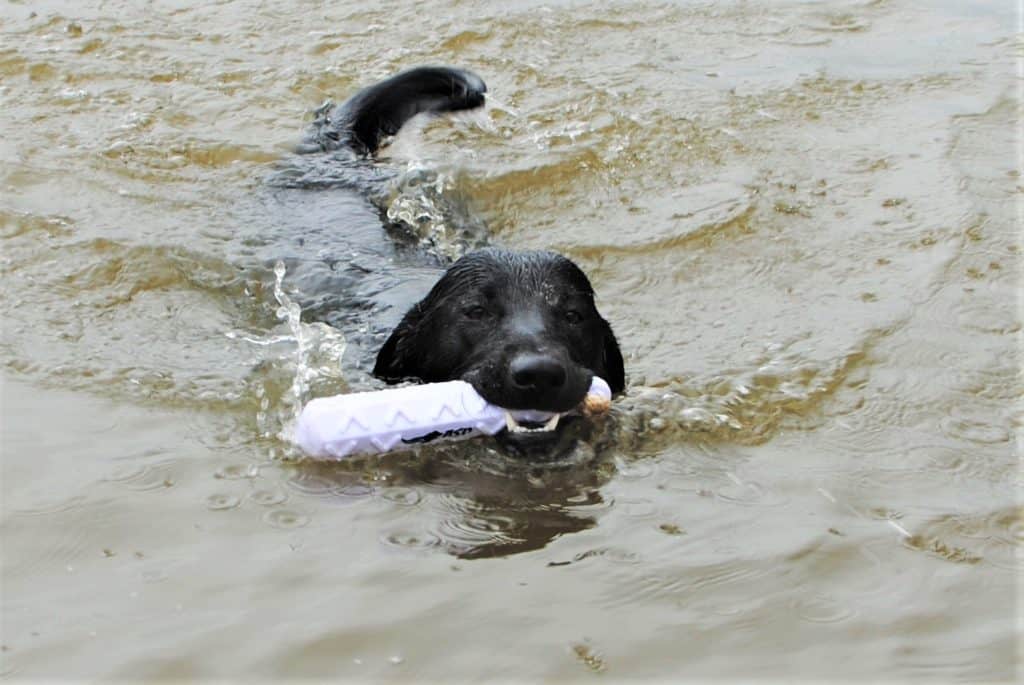Sporting Life

Have a Healthy Summer with a Labrador
By Dennis Doyle
Our Labrador retriever pup just turned one year old. Usually, this is when dogs of most breeds are coming into maturity. Hobbes, however, celebrated the milestone by vaulting his shiny black 75 pounds of bulk onto the couch, into my lap, turning over and licking my cheek with joy on his face.
Apparently, he is not even considering graduating from puppyhood just yet and insists on being as playful and happy as he’s ever been, and, frankly, I’m not arguing with it. Perhaps, and just for this reason, Labrador retrievers are the most popular dog in Maryland and the whole USA—and have been for a long while.
Though I’ve had many sporting dogs over the years, Hobbes is our first Lab and we’ve found him different from many other breeds. First of all, besides a long-lasting puppyhood, he has a greater insistence on exercise.
Actually, there are two different types of Labradors, though they are not officially recognized by the American Kennel Club. The first are known as English Labs, which are stockier, blocker, and more reserved in demeanor than the second. Allegedly this is because Labradors in England, where they were first popular, are used almost exclusively in the field for retrieving already downed birds. They do not actually take part in the hunt. There, and in the US, they are also the types used in bench trials where their physical appearance is the primary consideration.
American Labs, in contrast, are bred to actively hunt game birds, searching and thrashing around in all kinds of terrain, flushing the birds and retrieving them to hand. They have significantly higher energy levels than English Labs, are taller in the leg, slimmer, and more athletic. Those high-energy characteristics are not a problem for most pet owners during the colder months of the year. Throwing a handy ball or bumper for them to retrieve will endlessly encourage them in shedding excess energy and generally provides the pup with enough activity to satisfy his craving for action. Summertime, however, is when this characteristic can become a problem.
Heatstroke is a significant issue with any active breed during the warmer months. That issue is exacerbated by the Lab’s strong desire to please. They just don’t stop when things get uncomfortable. Since dogs cool themselves through panting and salivating, they can also rapidly suffer from dehydration.
When temps rise above 60 degrees it’s advisable to switch tactics and terrain for intensive exercise, especially with American Labradors. Swimming is by far the best and safest type of high-level activity. Overheating with any dog is rarely if ever, an issue in the water.
Labradors were originally bred long ago by Newfoundland fishermen as companions and assistants. They were often used in retrieving fish fallen overboard from their nets. The breed, theoretically, is genetically predisposed to aquatic adventure.
That quality was revealed to me shortly after Hobbes’ arrival to our home last spring, when, at only 12 weeks of age, he stumbled into our fish pond in the front yard. Based on my previous experiences, I was terrified of future problems that this might create, and, though quick to respond, I was not quick enough.
Hobbes had climbed out of the pond, shook himself off, turned around, and then eagerly jumped back in.
Fishfinder
The rockfish season has opened reasonably well with many anglers finding success. The pandemic may have a silver lining: it has significantly slowed the usual tsunami of trolling sport boats seeking out big fish in the early season and given our brooding stocks a chance to reproduce in relative peace. The cooler-than-usual spring, however, has also resulted in the later-than-usual presence of the large, post-spawn migratory stripers. Trolling is the traditional and most effective way to score one of these trophies. Since the minimum size is now 19 inches, chumming is usually the most efficient method this time of year but with a one-fish limit, it may not be worth the cost. Simply fishing cut bait or a big bloodworm on the bottom may be a more reasonable approach this season, though it may take the fish a bit longer to discover your offering. Jigging soft plastics is an acceptable alternative if you can find a concentration of rockfish. After the crabs come out of the mud, drifting softshells around structures will become even more effective. White perch are gathering well in the tributaries among the shoreline shallows and along the channel edges in about 12 feet of water and this year blue catfish have become quite the item. The cats are good eating and taking just about any bait that fits into their mouth though fresh menhaden is their favorite with nightcrawlers, chicken breast, chicken livers, razor clams, and cut white perch being next on their list. They can be found just about anywhere there are rockfish or white perch so hold on to your rod; they can and do grow to over 100 pounds.
